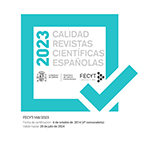Reproducción asistida, gestación por sustitución y creencias. Un análisis desde las usuarias de tecnologías, los expertos religiosos y las regulaciones estatales en Argentina
Resumen
Este artículo se propone contribuir al análisis sobre la relación de las TRHA y las religiones, entrecruzamiento que permite poner en debate no solo los sentidos sobre la reproducción, sino también sobre la sexualidad, la familia y los sentidos culturales sobre la vida humana. Trabajaremos en tres niveles: el de las regulaciones estatales y discursos jurídicos, el de los expertos religiosos y el de las usuarias religiosas de tecnologías reproductivas. Como métodos se utilizan las entrevistas biográficas a usuarias y análisis documental de legislación, resoluciones y fallos judiciales y literatura y cursos sobre fertilidad en espacios religiosos. Ante la ampliación del uso de las TRHA, los expertos religiosos católicos intentan proponer una alternativa que se adecúe a doctrina teológica. Sin embargo, las mujeres que se consideran católicas deciden utilizar las TRHA adecuando la doctrina a sus propias convicciones. Esto se da en el marco de un proceso de individuación y autonomía y cada vez menor influencia de las instituciones religiosas en la vida privada de las personas, como señalan los principales estudios en sociales sobre religión.
Descargas
Descarga artículo
Licencia
La revista Política y Sociedad, para fomentar el intercambio global del conocimiento, facilita el acceso sin restricciones a sus contenidos desde el momento de su publicación en la presente edición electrónica, y por eso es una revista de acceso abierto. Los originales publicados en esta revista son propiedad de la Universidad Complutense de Madrid y es obligatorio citar su procedencia en cualquier reproducción total o parcial. Todos los contenidos se distribuyen bajo una licencia de uso y distribución Creative Commons Reconocimiento 4.0 (CC BY 4.0). Esta circunstancia ha de hacerse constar expresamente de esta forma cuando sea necesario. Puede consultar la versión informativa y el texto legal de la licencia.











